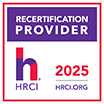Succession Planning: It's Not Just for Emergencies - It's a Leadership Development Strategy
60 Minutes
6 months
704873

Group Attendees: Any number of participants
Recorded Version: Unlimited viewing for 6 months ( Access information will be emailed 24 hours after the completion of live webinar)

The use of this seal confirms that this activity has met HR Certification Institutes (HRCI) criteria for recertification credit pre-approval.
This activity has been approved for
1 HR
(General) recertification credit
In the early morning hours of September 11, the world watched in horror as commercial jetliners crashed into the World Trade Center twin towers and the Pentagon.
In the midst of this national disaster, several organizations had to face the reality that they had lost, on the planes or in the buildings, key talent and brainpower. They immediately had to identify people and competencies to replace those who were no longer there.There's no way to plan for a disaster of the magnitude of the World Trade Center attacks. But, there are specific actions an organization can take to ensure it has the leadership it needs in case of a crisis, as well as, for their future sustainability.
Best-practice organizations use succession planning to not only prepare for potential leadership challenges but they also rely on such plans to develop and maintain the strong leadership that's required to grow and keep pace with changes in their business, industry, and overall marketplace.
The heart of succession planning is identifying and building your future leadership at all levels. Through your succession planning process, you recruit superior employees, develop their knowledge, skills, and abilities, and prepare them for advancement into ever more challenging roles. This will guarantee that you have a strong leadership bench on hand and ready to fill new or vacated roles. How effectively are you developing your organization's future leaders?
Why should you Attend: Succession planning isn't just naming the new CEO. In fact, it's not about putting a name behind a title at all. That's called replacement planning. And when it is only used during times of crisis -when a company has to name somebody to fill a vacant role quickly -that's not succession planning either. That's crisis management.
The goal of succession planning is to continuously identify and develop high-performing leaders capable of meeting the present and future needs of the organization. It should include a formal identification process supported by leadership development that builds leadership capacity within the organization.
Organizations are only as strong as their leaders. High performing organizations make leadership development, at all levels, a top priority. So how does your organization shape up? Which of the top best practices from high performance companies are being used in your organization to develop leaders? Which of these practices should you consider adopting to develop your future leaders? Succession planning will continue to become more integrated into the everyday life of organizations, moving from a formal 'annual event' to become a part of the daily fabric of doing business.
This webinar will cover these key areas for effective succession planning.
- How to identify your potential leaders who can assume greater responsibility in the organization
- The variety and impact of various development experiences to those that can move into key roles
- How to engage the leadership in supporting the development of high-potential leaders
Areas Covered in the Session:
- The focus of this webinar is to learn the elements of effective succession planning and will include these six objectives
- Discover the seven deadly sins of succession planning: What not to do!
- Examine the pros and cons of insiders vs outsiders to fill specific positions: Which is better?
- Understand the 70-20-10 rule for developing your future leaders: What it is and how to use it
- Identify the 10 best practices that high performing organizations use for grooming outstanding leaders
- Review the 5 steps that must be followed to build a culture that supports development from the top down
- Utilize the Center for Creative Leadership's 3 key elements with examples for successful leadership development: Assessment - Challenge -Support
Who Will Benefit:
- CEO's
- COO's
- VP of Human Resources
- Chief Learning Officer
- Directors
- Project Managers
- Operation Managers and Supervisors
- Team Leaders
- Human Resources Professionals
- Business Unit Managers
- Boards of Directors
- Senior Management Teams
- Executive Teams
 Marcia Zidle is a board-certified executive coach, business management consultant and keynote speaker, who helps organizations to leverage their leadership and human capital assets.
Marcia Zidle is a board-certified executive coach, business management consultant and keynote speaker, who helps organizations to leverage their leadership and human capital assets.
She has 25 years of management, business consulting and international experience in a variety of industries including health care, financial services, oil and gas, manufacturing, insurance, pharmaceuticals, hospitality, government and nonprofits.
She brings an expertise in strategy and alignment; social and emotional intelligence; executive and team leadership; employee engagement and innovation; personal and organization change management.
She has been selected one of LinkedIn Profinder’s top coaches for the past 5 years.
